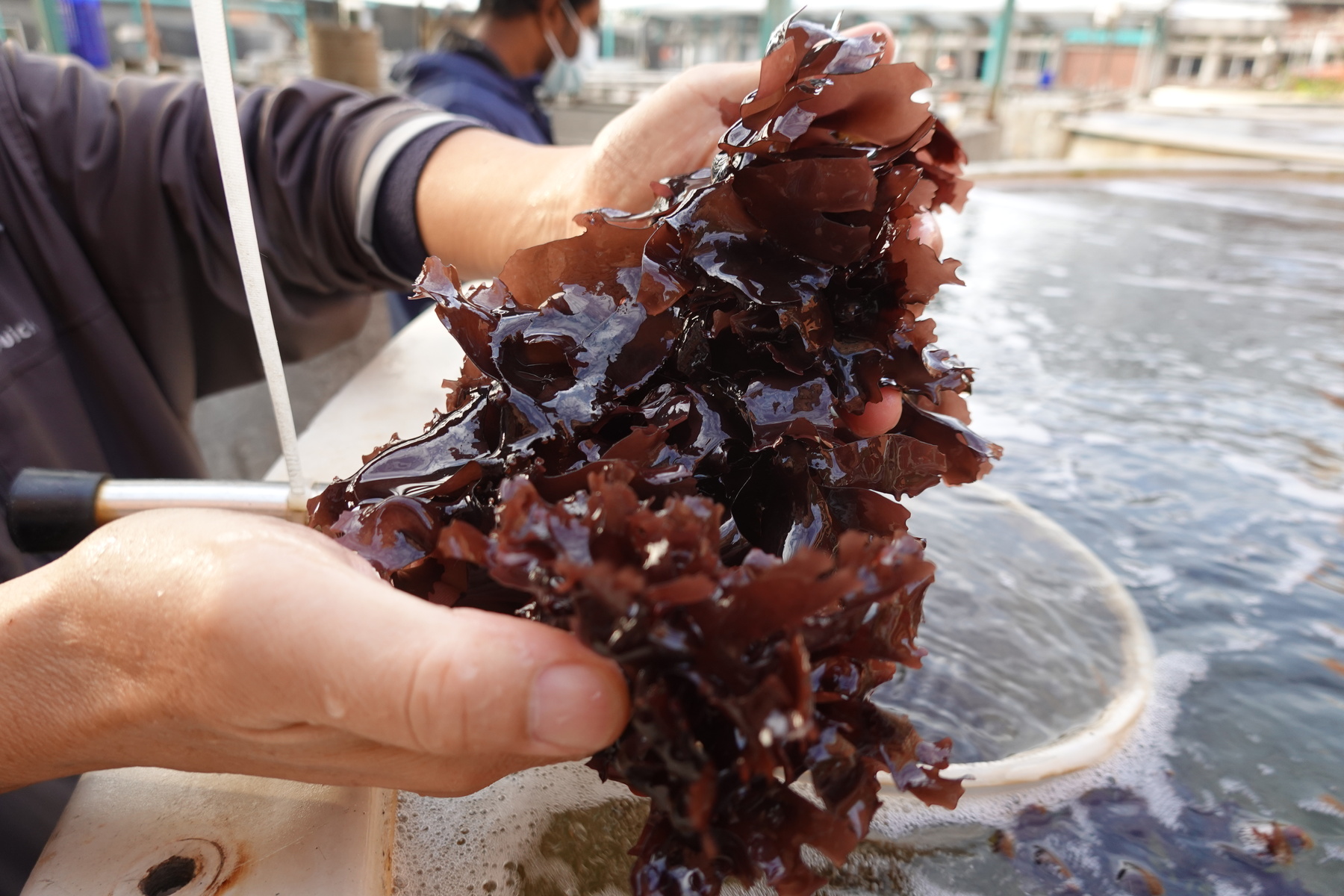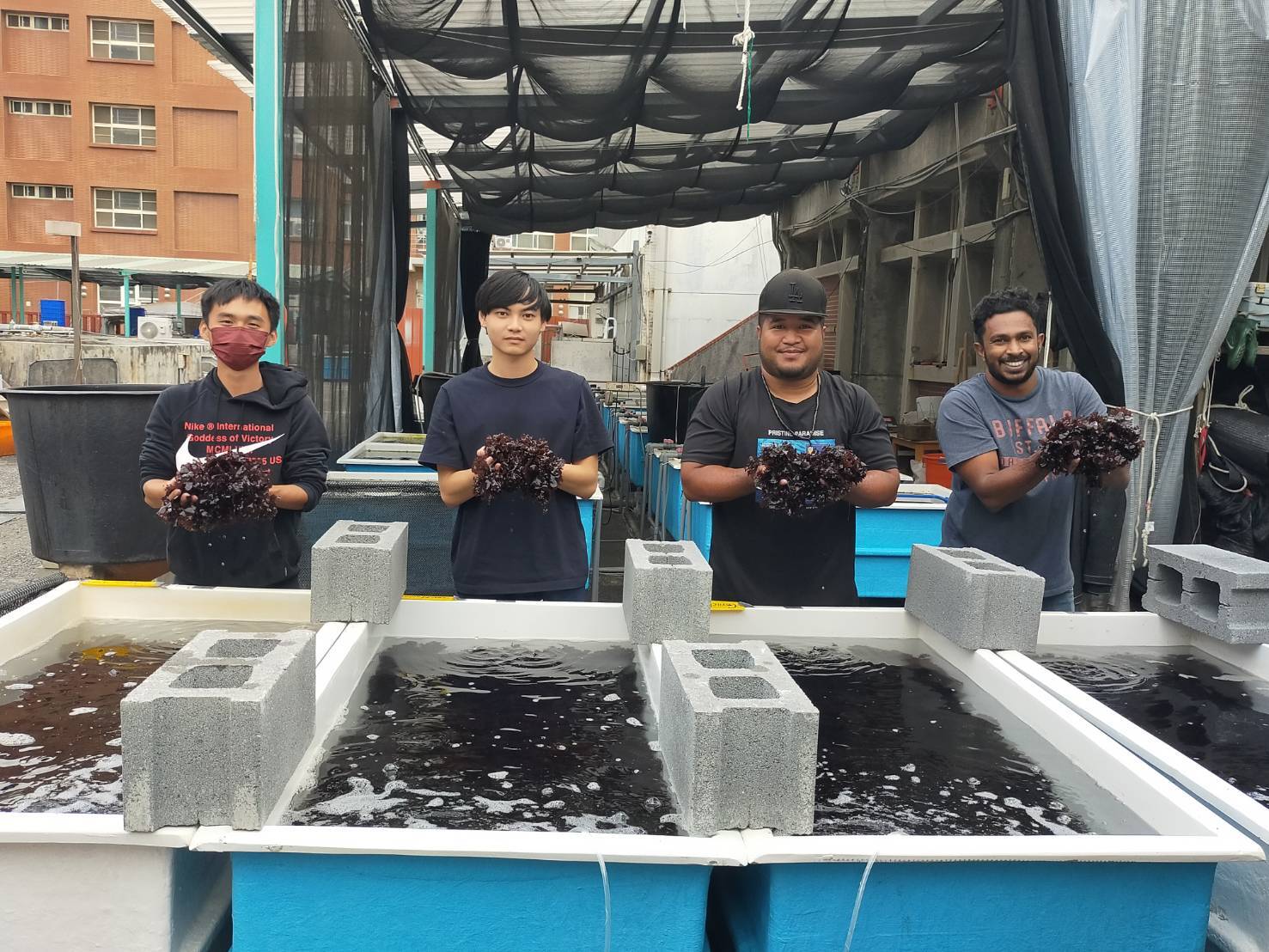NSYSU research results were published in an international science journal and identified the effective carbon fixation rate by seaweed Sarcodia suae
2023-06-13
Seaweeds represent an effective proxy to mitigate global warming. The research team led by Professor Chin-Chang Hung, Dean of the College of Marine Sciences at National Sun Yat-sen University (NSYSU), has announced the team’s result that the carbon fixation rate of seaweed Sarcodia suae in Taiwan is up to 30 tons per hectare per year, which is twice as high as that of Taipei Daan Forest Park. The team utilized a cooling system powered by green energy to overcome the obstacle that the temperature of coastal water in summer is too high for algae species to survive. In addition, the team has successfully filtered the aquaculture wastewater to decrease the turbidity of seaweed cultivation tanks. As a result, the objective to culture Sarcodia on a large scale under outdoor environments year-round has been successfully achieved. The research result has been published in the internationally recognized editorial “Science of the Total Environment.” The team also emphasized that this Sarcodia suae culture technique which enables scalable marine aquaculture will represent a strategic competence for Taiwan’s net zero carbon emissions policy.
Blue carbon includes carbon captured in the near-coastal regions by seagrasses, mangrove forests, and seaweeds. Professor Chin-Chang Hung indicated that the length of Taiwan’s coastline is approximately 1400 kilometers. Within 100 meters from the coast, the estimated area for seaweed or mangrove planting will be 140 square kilometers. Therefore, the capacity for carbon fixation will be limited. The more potential methodology is scalable Sarcodia suae culture in the maritime territory under the jurisdiction of the Taiwan government, which is approximately 180,000 square kilometers, to implement carbon fixation. Professor Hung’s research team has been measuring the carbon fixation rate of red seaweed Sarcodia suae from Liuqiu and found that the carbon capture rate is up to 30 tons per hectare per year. That is twice as high as that of Taipei Daan Forest Park (15 tons per hectare per year.) Moreover, the rate can be escalated to 50 tons per hectare per year with nutrient addition.
On the other hand, the best growth environment for Sarcodia suae and other seaweeds is seawater at a temperature under 25oC. From the end of April to early September, the coastal seawater temperature in Taiwan is generally too high for Sarcodia suae to process carbon fixation. Professor Hung’s team developed a solution using its solar-powered cooling system that allows cold air to enter condensation sticks, reducing water temperature. It has enabled Sarcodia suae growth to resume during the summer, allowing for continued carbon fixation.
Besides, the team has successfully overcome the cultivation tank turbidity issue. At first, they intended to apply the aquaponics mechanism, having seaweeds, fish, and shrimp cultured in the same environment to allow fish aquaculture wastewater releases nutrients for Sarcodia suae. However, the cultured turbidity was overly raised with a large amount of particulate matter and microalgae. With no photosynthesis occurrence, Sarcodia suae would be withered shortly. The team then used split-tank systems to filter aquaculture particles from the wastewater of fish and shrimp tanks. By converting the filtered wastewater into seaweed tanks as a nutrient addition, the carbon fixation rate of Sarcodia suae was significantly increased. The process also helped to alleviate the eutrophication caused by the fish and shrimp wastewater.
According to Professor Hung, seaweeds have been recognized as a valuable food product, with market prices ranging from 200-300 NT/kg. Fisheries Research Institute of Council of Agriculture collaborating industry professionals had successfully cultured many macroalgae species such as Sarcodia suae, Gracilaria, Coccoloba uvifera, and Agardhiella subulata. Those species were generally cultured in small tanks and used to produce food, health drinks, cosmetics products, and feeds. Few researchers dedicated their efforts to conducting experiments on the carbon fixation rate of large-scale macroalgae. Professor Hung’s team has successfully developed several environments containing 6-17 tons of marine water to cultivate seaweed, from which they can collect 50-80 kilograms of Sarcodia suae every week. The Sarcodia suae could be used in food and other product materials. Parts of the collected material that are not suitable for human consumption can be utilized for marine carbon fixation to help mitigate global warming.
“As carbon neutrality by 2050 is the acknowledged world mission, the need for carbon capture technology has continued to grow.” Professor Hung said. He emphasized that Taiwan’s natural resources, including carbon sinks forests, oceans, and wetlands, are not sufficient to neutralize the 290 million tons of carbon emissions produced by Taiwan. As the carbon trade market rises, Sarcodia suae carbon capture techniques significantly present great potential in many aspects. Since December 2022, the research team has created an experimental test in coastal region around Penghu. In 2023, the team will focus on identifying additional species suitable for carbon capture among the 500 seaweed species in Taiwan.
Journal article online link:
https://www.sciencedirect.com/science/article/pii/S0048969722059496?via%3Dihub




